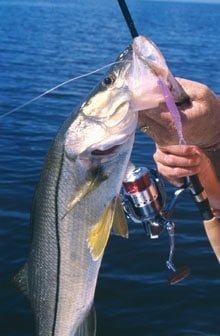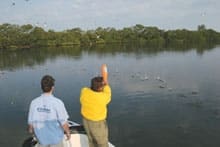
LUNKER LINESIDER: Tampa Bay guide Joel Brandenburg (right) helps heft a big cold-front snook.
Photo: Bob McNally
By the time March slammed the Northeast last year, I had reached my limit. I was tired of freezing my butt off and more than a little desperate to catch some snook.
Coincidentally, I was listening to the broadcast of the Yankees-Rangers preseason game from Tampa when they called my flight to Tampa.
“It’s a chilly night here at the ballpark,” announcer John Sterling said. “Feels more like fall in the Bronx than March in Florida.”
I guess that explains the double takes when I finally arrived at my hotel at two in the morning wearing shorts and a T-shirt.

| |REEL DEAL: Soft-plastics are snook killers any time of the year. Photo: Bob McNally| Great. I had two days to shake off winter and flew directly into a cold front. And when you’re snook fishing, a cold front is not a good thing.
Just an hour or so after my head hit the pillow, the phone rang.
“Gerry?” friend and Tampa Bay guide Joel Brandenburg asked rhetorically. “Here’s the deal. Get an extra hour or three of sleep. I’m going to get bait. No sense in us both getting the crap beat out of us out in this wind and cold. I’ll call you later and we’ll go snook fishing.”
Although I sometimes like catching bait as much as I like catching fish, the decidedly un-Florida-like temperature and howling wind caused me to enthusiastically accept Brandenburg’s kind and generous offer.
By 9 a.m. we were free-lining whitebait near residential boat docks as the words of another of Tampa Bay’s fine guides, Dave Markett, rang in my ears.
“I don’t know anyone who can catch big snook when there’s a fresh ‘blue-norther’ cold front blowing hard on the water,” he said. “I don’t even mess with snook during those conditions. I’ll wait until the weather changes and warms a bit and then target snook after the third or fourth day of a warm-up.”
I had no such luxury and, besides, Brandenburg was charging far too hard to be stopped. We fished intensely all day for our steady pick of snook. It left me wanting to pick the brains of some of Florida’s finest guides to gather some secrets to catching snook in the cold. Here’s how five of the best turn on the winter bite.
The Guides:
Joel Brandenburg is one of the young guns in the Tampa Bay area and is a regular winner of inshore tournaments on his home water. (813) 267-4401

| |CHUM AND GET IT: Joel Brandenburg turns on the snook bite by chumming stunned whitebait with a sawed-off waffle-ball bat. Photo: Bob McNally|
Phil O’Bannon is a renowned Boca Grande fishing guide and a big snook specialist. (941) 964-0359
Lori Deaton is a well-known inshore fishing guide on Tampa Bay, who specializes in snook, tarpon, redfish and seatrout. (813) 967-5032
Dave Markett is one of the best-known snook, tarpon and redfish guides in the Tampa Bay area. (813) 962-1435
Scott Moore is one of Florida’s premier snook guides. Raised on Ana Maria Island, he catches snook everywhere he goes, including Pine Island Sound and Charlotte Harbor. (941) 713-1921
1. POWER MOVE
The colder the weather and water, the better the snook fishing can be around power-plant discharge water outflows. Snook are very susceptible to cold water, and the warm water flowing out of power-generating stations attracts snook and baitfish, too. When surface water temperature is in the 50s, power-plant outflow water is often in the mid- to high 60s, and that’s a real draw for snook. – J.B.
2. GAUGE IT
Residential canals are great winter fishing spots.

| |BAIT-MASTER: Joel Brandenburg with a day’s worth of bait. Photo: Bob McNally| The very best places are hit with direct sunlight through most of the day, which gets the water a little warmer. The very backs of dead-end canals where there is little or no water movement are best because they stay warmest the longest. Use your boat’s temperature gauge and find the warmest water you can in canals for the best fishing. – P.O’B.
3. TAKE TWO
I have two very different places I fish for winter snook in the coldest weather conditions: way up fresh water rivers that feed large estuaries and in residential canals at night. – L.D.
4. IT’S A BEACH
Not all snook move up tidal rivers in winter. There’s a domestic population of snook that live in beach areas and nearby canals, and they live there year-round. They are almost like different stocks of snook than those that migrate way up rivers in winter. I’ve really seen a huge increase in the population of these snook since the Florida net ban went into effect some years ago. – S.M.
5. BEST BAIT
Anchor up in a residential canal and free-line a greenback herring hooked behind the pectoral fin. During low tide, with the wind at your back, it’s deadly for winter snook. Low or mid-low tides are best, so you can cast baits well under docks. Mouths of canals can also be very productive. – J.B.
6. SHRIMP TIME
In winter, snook often quit feeding on whitebait and prefer to eat shrimp because they’re easier for them to catch. So shrimp can be the ticket to the best winter snook fishing.

| |HOT BITE: Lori Deaton makes her living by guiding anglers to big snook. Photo: Bob McNally| I’ve had excellent success using jigs tipped with artificial shrimp like a Berkley Gulp! – P.O’B.
7. SHINE ON
I think a 12-inch live shiner-like those bass fishermen use for largemouths-is the best ticket to a big winter snook. Next-best baits are four- to six-inch tilapia. I slow-troll them around river structure with an electric motor. I nose-hook them with a 3/0 Owner hook, using 14-pound Berkley Fireline and a 30-pound monofilament leader. – D.M.
8. DRIFT AWAY
Casting and drifting with live shrimp and pinfish are the best ways to catch winter snook, and no chumming is involved because I’ve found that it’s not as effective in winter. – S.M.
9. GREAT EATS
Biologists say pinfish are the number-one food found in snook stomachs and I absolutely believe it. – J.B.
10. SHHHHHH
You’ve got to be very quiet fishing rivers in winter for snook.

| |Photo: Bob McNally| Use the electric motor very sparingly. Instead, drift with the current, and only nudge the boat periodically to position it correctly for casting. Controlled drifting is better than trolling with the motor, because even the slightest noise can turn off snook. – L.D.
11. TIDAL URGES
Ideal winter snook conditions are the last of a falling tide at 2 to 3 p.m. following a bright sunny day with little or no wind. But just as you start fishing, a light overcast covers the sun, which will make snook most active. I fish far up tidal rivers with live baits around trees, docks, riprap and points with little current. – D.M.
12. SHINE ON
It’s almost cheating to fish at night in winter for snook, especially around docks with lights. The biggest snook are in dark areas well away from lights shining down into the water. Live baits work well around dock lights, but sometimes a white bucktail jig is great, perhaps with a red ribbon throat. D.O.A. Shrimp lures also work well around dock lights in winter. – S.M.









